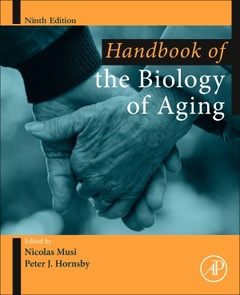Description
Handbook of the Biology of Aging (9th Ed.)
Handbooks of Aging Series
Coordinators: Musi Nicolas, Hornsby Peter
Language: English
Subjects for Handbook of the Biology of Aging:
Keywords
Acetylation; Acylation; Adaptive immunity; Age-associated disease; Age-related disease; Aging; Aging hallmarks; Apoptosis; Autophagy; B cell; Bee; Beige adipose tissue; Bioinformatics; Biological networks; Brown adipose tissue; C elegans; Calorie restriction; Cancer; Cardiac aging; Cellular senescence; Chemosensory; Chronological lifespan; Cochlea; Complex trait; Compression of morbidity; DNA damage; Deterioration; Diastolic function; Drosophila; Environmental temperature; Extracellular matrix; Eye; Flatworm; Frailty; Functional; Functional genomics; GWAS; Gene mapping; Genetics; Genomics; Geroscience; Health; Health and retirement study; Health trends; Healthspan; Healthy life expectancy; Heart failure; Heterogeneous mice; Hormone signaling; Human aging; Hydra; Hypertrophy; Hypothesis; Immunodeficiency; Immunogerontology; Immunosenescence; Inflammation; Innate immunity; Inner ear; Insulin/IGF-1 signaling; Lifespan; Longevity; MTOR; Material; Mechanism; Metabolism; Microbiota; Mitochondria; Mitochondrial dysfunction; Model organism; Model organisms; Mollusk; Morbidity; MtDNA mutations; Multimorbidity; NAD+; Nonhuman primate models; Oxidative stress; Probiotic; Progeroid disorders; Proteomics; QTL; Rapamycin; Replicative lifespan; Retina; Rotifer; Senescence; Senolytic; Senolytics; Senostatic; Senotherapeutics; Sensory perception; Sirtuin activators; Sirtuin inhibitors; Sirtuins; Stem cell; Systems biology; T cell; Telomeres; Thermogenesis
468 p. · 21.4x27.6 cm · Paperback
Description
/li>Contents
/li>Readership
/li>Biography
/li>Comment
/li>
Part I: Basic mechanisms, underlying physiological changes, model organisms and interventions
1. Longevity as a complex genetic trait
2. DNA damage and repair in aging
3. Mechanisms of cell senescence in aging
4. The nature of aging and the geroscience hypothesis
5. Sirtuins, healthspan, and longevity in mammals
6. Integrative genomics of aging
7. Thermogenesis and aging
8. Yeast as a model organism for aging research
9. Model organisms (invertebrates)
10. NIA Interventions Testing Program: A collaborative approach for investigating interventions to promote healthy aging
11. Aging in nonhuman primates
Part II: Organ systems in humans and other animals, human health and longevity
12. Senotherapeutics: Experimental therapy of cellular senescence
13. The role of neurosensory systems in the modulation of aging
14. Aging of the sensory systems: hearing and vision disorders
15. Cardiac aging
16. The aging immune system: Dysregulation, compensatory mechanisms, and prospects for intervention
17. Microbiome changes in aging
18. Lipidomics of aging
19. Trends in morbidity, healthy life expectancy, and the compression of morbidity
Clinicians, researchers, and students in gerontology, developmental psychology, psychiatry, biology, and other related health care professions tasked with caring for the aging population.
Dr. Peter Hornsby obtained a Ph.D. in Cell Biology at the Institute of Cancer Research of the University of London. He has held faculty positions at the University of California SanDiego, the Medical College of Georgia, and Baylor College of Medicine. Currently he is Professor in Department of Physiology and Barshop Institute for Longevity and Aging Studies, University of Texas Health Science Center, San Antonio.
- Assists researchers in keeping abreast of research and clinical findings outside their subdiscipline
- Helps medical, behavioral and social gerontologists understand what basic scientists and clinicians are discovering
- Includes new chapters on genetics, evolutionary biology, bone aging, and epigenetic control
- Examines the diverse research being conducted in the study of the biology of aging

